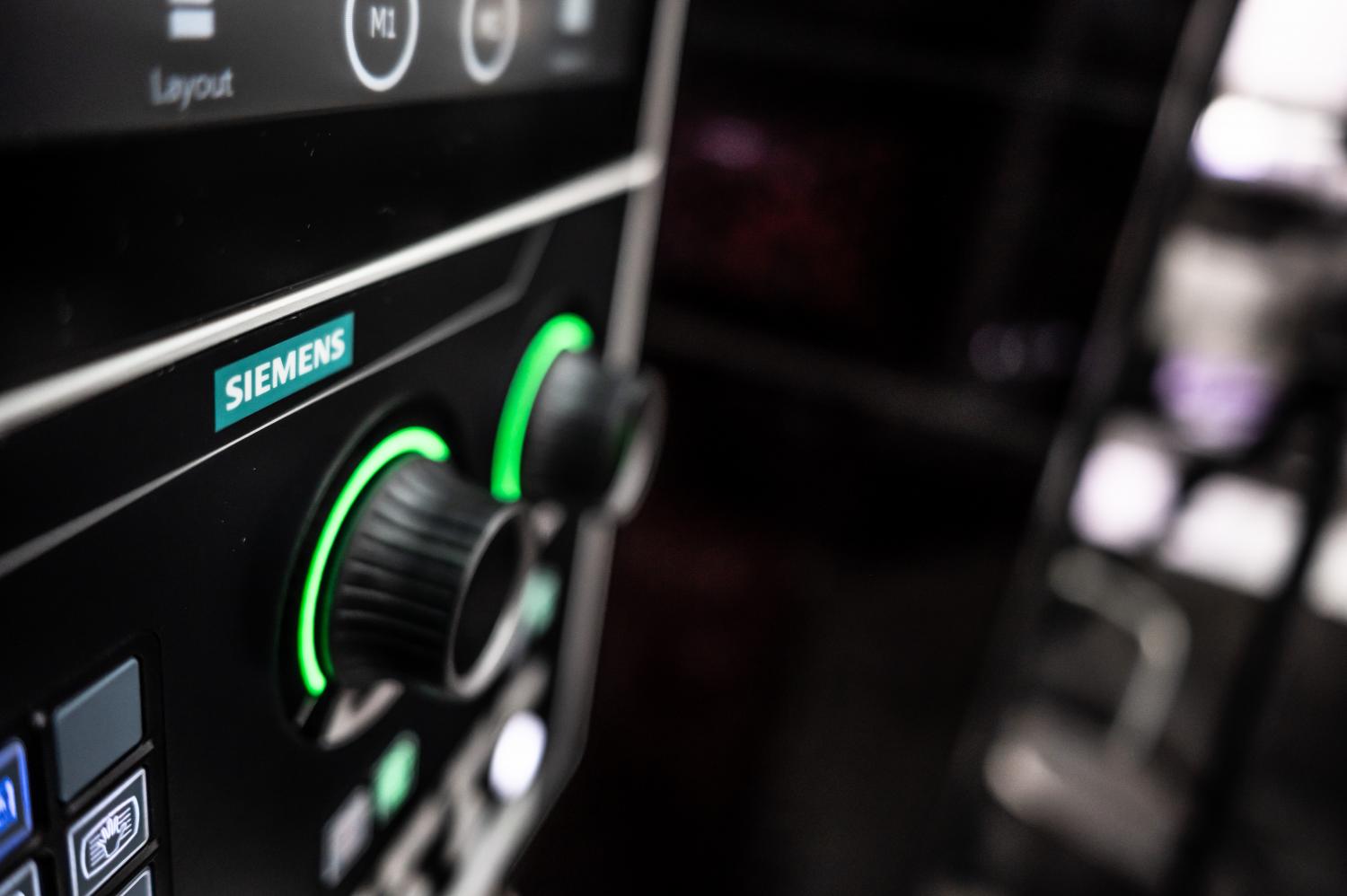Digital Industries, Motion Control, Machine Tool Systems
More precise processing - compensation functions

Siemens provides a range of compensation functions for the SINUMERIK control that lead to better results in machining.
Compensation functions
Systematic, machine-specific deviations in machine tools are detected during professional commissioning and are displayed via settings on the CNC system. But deviations can also arise or be exacerbated during later operational processes because of environmental factors such as temperature or mechanical load. For these instances, the SINUMERIK offers a range of compensation functions that complement one another. Using the actual position value encoders as well as additional sensor technology and measurements, measured deviations can be compensated for, leading to better results. Useful SINUMERIK cycles such as "CYCLE996 - measure kinematics" support the end user in the continuous monitoring and maintenance of machines.

During a transfer of force between a moving machine part and its drive - a ball-bearing spindle, for example - gaps occur because a completely backlash-free mechanical set-up would dramatically increase wear on the machine and is also unachievable from a processing standpoint. Mechanical gaps cause deviations in the traverse path of axes/spindles with indirect measuring systems. This means that in the event of a change in direction, for example, the axis will travel too far or not far enough, depending upon the size of the gap. The machine table and its associated encoder are also affected: if the encoder is ahead of the machine table, it will reach the measured actual value position earlier, meaning in real terms that the machine’s traverse path is too short. While the machine tool is in operation, the previously recorded deviations will be activated automatically and, using the backlash compensation on the corresponding axes, added to the actual position value when the direction is reversed.

The measuring principle for indirect measurement in CNC-controlled systems assumes that the pitch of the ball-bearing spindle is constant at every point within the traverse area, meaning that ideally the axis’ actual position is deduced from the position of the drive spindle. Production tolerances for ball-bearing spindles, however, can result in measuring deviations known as spindle-pitch errors. The problem is further exacerbated by measurement deviations that are dependent on the measurement system used, as well as the latter’s installation tolerances on the machine, known as measurement system errors. In order to compensate for these two errors, the CNC machine’s natural error curve is measured using a separate measurement system (laser measuring), and the required correction values are saved in the CNC system.

Quadrant error compensation (also called friction compensation) serves above all to significantly increase contour accuracy while machining circular contours. The reason: at quadrant transitions, one axis moves at maximum path speed while the second axis is stationary. The different frictional behaviors of the axes can therefore cause contour errors. Quadrant error compensation reliably offsets this malfunction and enables excellent results without contour error in the first Phase of machining. The intensity of the correctional impulse can be set according to a characteristic curve linked to acceleration. This characteristic curve is determined and parameterized with the help of a circular shape test. In the circular shape test, the deviations in the actual position from the programmed radius (particularly at Quadrant transitions) during the description of a circular contour are metrologically recorded and graphically represented.

Sag compensation is implemented if the weight of individual machine elements leads to the positional displacement and incline of moving parts, as this results in related machine parts - including guide systems - sagging. Angularity error compensation is used when movement axes are not properly aligned with each other at the correct angle (e.g. vertically). As the deviation from the zero position increases, positioning errors also increase. Both types of error can result from the machine’s own weight as well as from tools and workpieces. The measured correction values are calculated metrologically during commissioning and stored according to position in SINUMERIK - in the form of a compensation table, for example. During machine tool operation, the relevant axis is interpolated between the table values’ data points. For each continuous path motion there is always both a basic axis and a compensation axis. If the y-axis’ perpendicularity is not present in the continuous path of the x-axis and the y-axis, this inaccuracy is compensated for by the x-axis in the continuous path.
Heat can cause machine parts to expand. The extent of expansion is dependent upon the temperature and heat conductivity of the machine parts, among other things. Different temperatures can result in changes to the actual positions of the individual axes, which have a negative effect on the accuracy of the workpieces being machined. These actual value changes can be offset with temperature compensation. Error curves for different temperatures can be defined for each axis. In order to always correctly compensate for heat expansion, the temperature compensation value, reference position and linear gradient angle parameters must be constantly retransmitted via function blocks from the PLC to the CNC control system. Abrupt parameter changes are automatically smoothed out by the control system in order to avoid overloading the machine and triggering the monitoring function.
Volumetric Compensation System (VCS)
Because of the positions of the rotary axes, their mutual offsetting and the orientation of the tool, parts such as turn and swivel heads may exhibit systematic geometric errors. Additionally, small errors in the guide system for feed axes will arise in every tool machine: for linear axes, these will be linear positional errors; horizontal and vertical straightness errors; and pitch, yaw and roll. Other errors may arise when aligning the machine components with one another - perpendicularity errors, for example. In a three-axis machine, that means there are 21 geometry errors that can be ascribed to the tool holder: six error types per linear axis multiplied by three axes, plus three angle errors. These deviations join together to form a total error, known as a volumetric error.
The volumetric error describes the deviation of the real, error-prone machine’s tool center point (TCP) position from that of an ideal, fault-free machine. SINUMERIK Solution Partners are able to determine volumetric errors with the help of laser measuring devices. All machine errors in the entire machining space must also be measured. Measuring individual errors is not sufficient. It is always entire measuring curves that are recorded, as individual error sizes are dependent upon the position of the relevant feed axis and on the measuring location. For example, errors that are attributed to the x-axis turn out differently if the y-axis and z-axis are in different positions — even if the errors are at the very same position on the x-axis. With the help of "CYCLE996 - measure kinematics," rotary axis errors can be determined in just a few minutes. This means the machine’s accuracy can be constantly checked, and if necessary corrected, even during production.
Deviation error compensation (dynamic precontrol)
A deviation error refers to the position controller’s deviation from the norm during machine axis movement. The axial deviation error is the difference between the machine axis’ target position and its actual position. A deviation error leads to an undesired speed-dependent contour error, especially during acceleration on contour curvatures - circles and squares, for example. With the NC high-level language command "FFWON" in the workpiece program, the speed-dependent deviation error is reduced toward zero during path-based movement. Movement with precontrol enables increased path accuracy and as a consequence better processing results.
Syntax:
-
FFWON: Command to turn on precontrol
-
FFWOF: Command to turn off precontrol
In extreme cases, in order to prevent the axes from sagging and damage being caused to the machine, tool or workpiece, electronic counter-balancing can be activated. In weight-loaded axes without mechanical or hydraulic counter-balancing, the vertical axis sags undesirably after the brake is released and the controller release is switched on. This undesired axis sagging can be compensated for by activating electronic counterbalancing. After the brake is released, the constant weight counterbalance torque maintains the position of the sagging axis.





